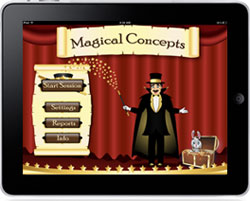Category Carousel: This app was developed by speech pathologist Lois Kam Heymann. The app offers nine general categories: transportation, animals, clothing, food, occupations, household, summer, winter and instruments. There are subcategories within animals (birds, bugs, farm, water, jungle, forest), transportation (land, water, sky), clothing (body, head, feet), food (breakfast, desserts, drinks, meat, fruit, vegetables), and household (cleaning, furniture, toys, tools, bathroom, kitchen). The screen for each category presents 12 photographs of items within the category selected. The child needs to drag each of the pictures into the category icon at the top of the screen. Each picture touched is named and when it is dragged into the icon two things happen: the number of items placed into the icon are counted and shown with a number and there is verbal praise. I like the large variety of items presented for some categories. For the categories with many pictures, each time a picture is placed in the icon, new picture appears on the screen so that there are always 12 pictures from which to select until the picture limit is reached. Some categories, such as winter, have only 12 pictures. One has the option of rotating the pictures on the screen by tapping the circular arrows at the bottom.
Although the focus of this app is categories there really is no challenge for the child in this respect. This is because the child does not need to determine the category nor sort pictures according to their categories. The challenge only occurs when the child needs to sort pictures into their subcategories. This app, however, is a good choice for vocabulary learning.
Ages: 3-8
Ratings: +++
Developer website: pocketslp.com
Cost: $9.99
Ratings: +++
Developer website: pocketslp.com
Cost: $9.99
Clean Up Category Sorting: This app focuses on three categories—foods, toys, and clothing. An item appears on the screen. It is named and the narrator asks, “Where does/do the _____go?” The child plays the game by dragging the item into either a shopping cart, toy bin, or clothes closet at the bottom of the screen. This limits the learning of categories to three: food, toys, and clothes. A correct answer elicits a positive narrator response such as “Yah,” “Way to Go,” or clapping accompanied by a fleeting visual reward of either thumbs up, blue ribbon, star, confetti, or balloons. After all the items have been placed, a score screen shows the percentage correct for the session. There is no database for storing the scores of the children who use the app. This app can also be used for vocabulary building.
Lacking any creative elements, this app is basic and bland. The items that appear on the screen are photos common to the paper materials that have been around for years.
Ages: 2-4
Ratings: +
Developer website: Difflearn.com
Cost: $1.99
Ratings: +
Developer website: Difflearn.com
Cost: $1.99
The drawn pictures are clear and pleasant. I like the variety of general categories as well as the inclusion of the higher level concept of subcategory learning. There is also a lot of vocabulary to enhance the learning process. The pictures in Family 1 are more visually similar, making this app easier than Families 2
Ages: 2-5 for Families 1; 3-5 for Families 2
Ratings: +++
Developer website: myfirstapp.com
Cost: Free for two categories for each of the apps. One can upgrade to eight groups for $.99.
Ratings: +++
Developer website: myfirstapp.com
Cost: Free for two categories for each of the apps. One can upgrade to eight groups for $.99.
Ages: 3-5
Ratings: +
Developer website: brain-go.com
Cost: Free for the first level; $1.99 for the nine additional levels.
Ratings: +
Developer website: brain-go.com
Cost: Free for the first level; $1.99 for the nine additional levels.

